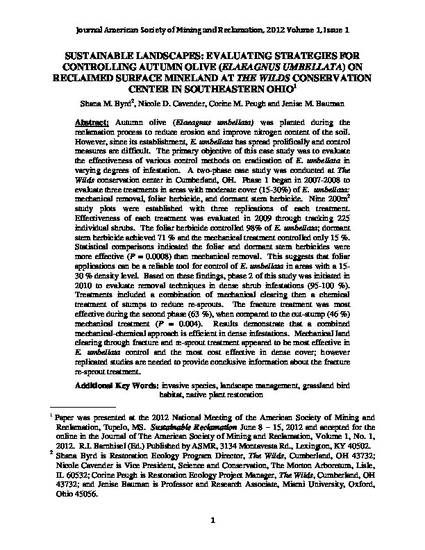
- Invasive species,
- Landscape management,
- Grassland bird habitat,
- Native plant restoration
Autumn olive (Elaeagnus umbellata) was planted during the reclamation process to reduce erosion and improve nitrogen content of the soil. However, since its establishment, E. umbellata has spread prolifically and control measures are difficult. The primary objective of this case study was to evaluate the effectiveness of various control methods on eradication of E. umbellata in varying degrees of infestation. A two-phase case study was conducted at The Wilds conservation center in Cumberland, OH. Phase 1 began in 2007-2008 to evaluate three treatments in areas with moderate cover (15-30%) of E. umbellata: mechanical removal, foliar herbicide, and dormant stem herbicide. Nine 200m2 study plots were established with three replications of each treatment. Effectiveness of each treatment was evaluated in 2009 through tracking 225 individual shrubs. The foliar herbicide controlled 98% of E. umbellata; dormant stem herbicide achieved 71 % and the mechanical treatment controlled only 15 %. Statistical comparisons indicated the foliar and dormant stem herbicides were more effective (P = 0.0008) than mechanical removal. This suggests that foliar applications can be a reliable tool for control of E. umbellata in areas with a 15- 30 % density level. Based on these findings, phase 2 of this study was initiated in 2010 to evaluate removal techniques in dense shrub infestations (95-100 %). Treatments included a combination of mechanical clearing then a chemical treatment of stumps to reduce re-sprouts. The fracture treatment was most effective during the second phase (63 %), when compared to the cut-stump (46 %) mechanical treatment (P = 0.004). Results demonstrate that a combined mechanical-chemical approach is efficient in dense infestations. Mechanical land clearing through fracture and re-sprout treatment appeared to be most effective in E. umbellata control and the most cost effective in dense cover; however replicated studies are needed to provide conclusive information about the fracture re-sprout treatment.
Available at: http://works.bepress.com/jenise_bauman/11/
